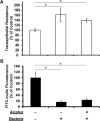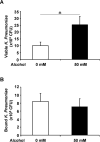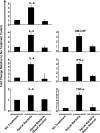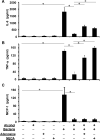Response of Differentiated Human Airway Epithelia to Alcohol Exposure and Klebsiella Pneumoniae Challenge
- PMID: 25485141
- PMCID: PMC4255281
- DOI: 10.3390/medsci1010002
Response of Differentiated Human Airway Epithelia to Alcohol Exposure and Klebsiella Pneumoniae Challenge
Abstract
Alcohol abuse has been associated with increased susceptibility to pulmonary infection. It is not fully defined how alcohol contributes to the host defense compromise. Here primary human airway epithelial cells were cultured at an air-liquid interface to form a differentiated and polarized epithelium. This unique culture model allowed us to closely mimic lung infection in the context of alcohol abuse by basolateral alcohol exposure and apical live bacterial challenge. Application of clinically relevant concentrations of alcohol for 24 hours did not significantly alter epithelial integrity or barrier function. When apically challenged with viable Klebsiella pneumoniae, the cultured epithelia had an enhanced tightness which was unaffected by alcohol. Further, alcohol enhanced apical bacterial growth, but not bacterial binding to the cells. The cultured epithelium in the absence of any treatment or stimulation had a base-level IL-6 and IL-8 secretion. Apical bacterial challenge significantly elevated the basolateral secretion of inflammatory cytokines including IL-2, IL-4, IL-6, IL-8, IFN-γ, GM-CSF, and TNF-α. However, alcohol suppressed the observed cytokine burst in response to infection. Addition of adenosine receptor agonists negated the suppression of IL-6 and TNF-α. Thus, acute alcohol alters the epithelial cytokine response to infection, which can be partially mitigated by adenosine receptor agonists.
Keywords: Adenosine receptor; Air-liquid interface culture; Alcohol; Cytokines; Epithelial barrier function; Human airway epithelia; Klebsiella pneumoniae bacteria.
Conflict of interest statement
No conflicts of interest, financial or otherwise, are declared by the authors.
Figures






Similar articles
-
Paracellular permeability restricts airway epithelial responses to selectively allow activation by mediators at the basolateral surface.J Immunol. 2007 May 15;178(10):6395-403. doi: 10.4049/jimmunol.178.10.6395. J Immunol. 2007. PMID: 17475869
-
Polarization of protease-activated receptor 2 (PAR-2) signaling is altered during airway epithelial remodeling and deciliation.J Biol Chem. 2020 May 8;295(19):6721-6740. doi: 10.1074/jbc.RA120.012710. Epub 2020 Apr 2. J Biol Chem. 2020. PMID: 32241907 Free PMC article.
-
Polarized secretion of interleukin (IL)-6 and IL-8 by human airway epithelia 16HBE14o- cells in response to cationic polypeptide challenge.PLoS One. 2010 Aug 12;5(8):e12091. doi: 10.1371/journal.pone.0012091. PLoS One. 2010. PMID: 20711426 Free PMC article.
-
Development, validation and implementation of an in vitro model for the study of metabolic and immune function in normal and inflamed human colonic epithelium.Dan Med J. 2015 Jan;62(1):B4973. Dan Med J. 2015. PMID: 25557335 Review.
-
Participation of the IL-10RB Related Cytokines, IL-22 and IFN-λ in Defense of the Airway Mucosal Barrier.Front Cell Infect Microbiol. 2020 Jun 19;10:300. doi: 10.3389/fcimb.2020.00300. eCollection 2020. Front Cell Infect Microbiol. 2020. PMID: 32637365 Free PMC article. Review.
Cited by
-
TLR2 and TLR4 Expression and Inflammatory Cytokines are Altered in the Airway Epithelium of Those with Alcohol Use Disorders.Alcohol Clin Exp Res. 2015 Sep;39(9):1691-7. doi: 10.1111/acer.12803. Epub 2015 Jul 24. Alcohol Clin Exp Res. 2015. PMID: 26208141 Free PMC article.
-
Dual Role of Hydrogen Peroxide as an Oxidant in Pneumococcal Pneumonia.Antioxid Redox Signal. 2021 Apr 20;34(12):962-978. doi: 10.1089/ars.2019.7964. Epub 2020 Aug 14. Antioxid Redox Signal. 2021. PMID: 32283950 Free PMC article. Review.
-
Pneumococcal hydrogen peroxide-induced stress signaling regulates inflammatory genes.J Infect Dis. 2015 Jan 15;211(2):306-16. doi: 10.1093/infdis/jiu428. Epub 2014 Sep 2. J Infect Dis. 2015. PMID: 25183769 Free PMC article.
-
Altered gut microbe metabolites in patients with alcohol‑induced osteonecrosis of the femoral head: An integrated omics analysis.Exp Ther Med. 2024 Jun 5;28(2):311. doi: 10.3892/etm.2024.12599. eCollection 2024 Aug. Exp Ther Med. 2024. PMID: 38873043 Free PMC article.
References
-
- Nelson S, Kolls JK. Alcohol, host defence and society. Nat Rev Immunol. 2002;2:205–9. - PubMed
-
- Zhang P, Bagby GJ, Happel KI, Raasch CE, Nelson S. Alcohol abuse, immunosuppression, and pulmonary infection. Curr Drug Abuse Rev. 2008;1:56–67. - PubMed
-
- Knight DA, Holgate ST. The airway epithelium: structural and functional properties in health and disease. Respirology. 2003;8:432–46. - PubMed
-
- Voynow JA, Rubin BK. Mucins, mucus, and sputum. Chest. 2009;135:505–12. - PubMed
Grants and funding
LinkOut - more resources
Full Text Sources
Other Literature Sources
